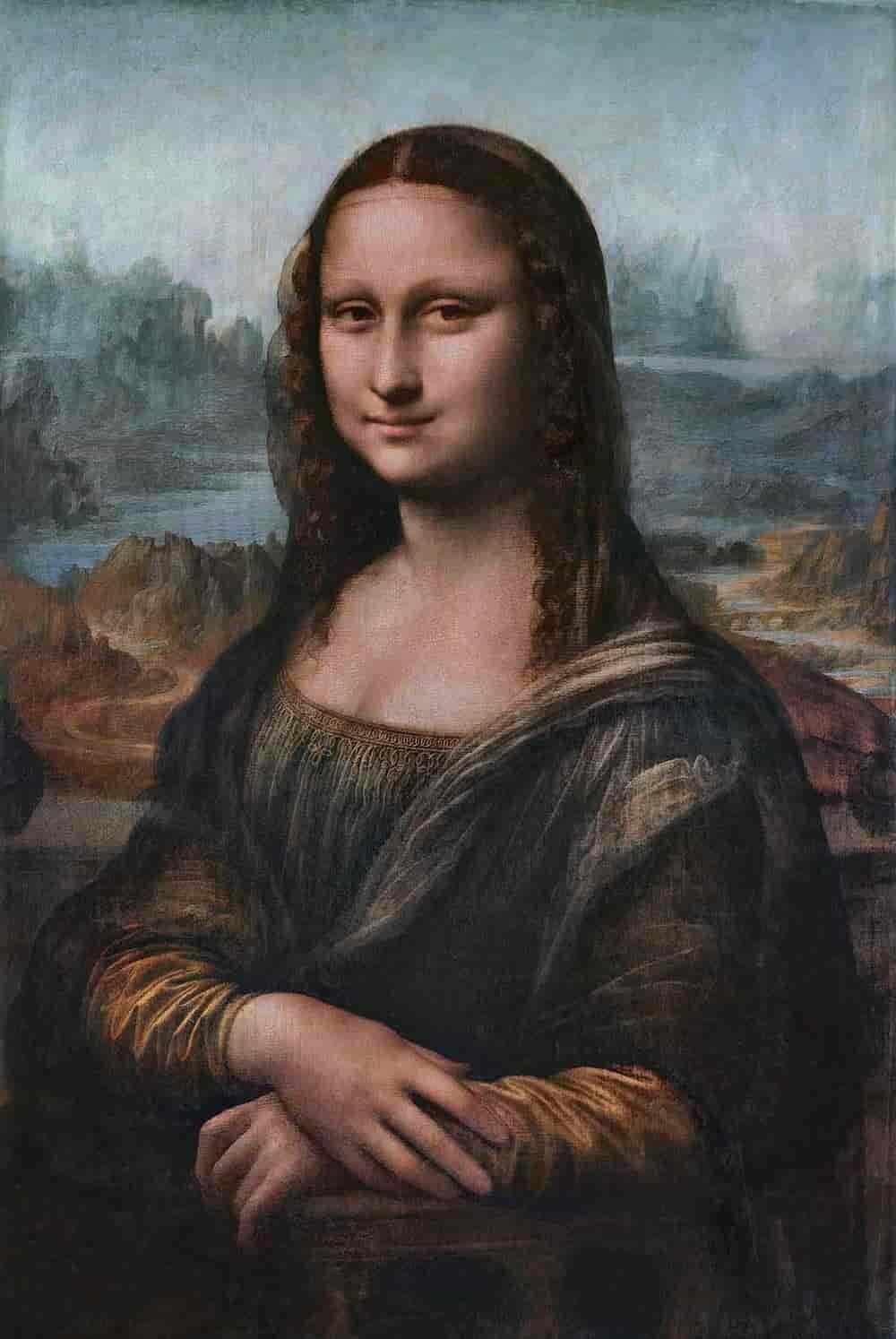Mona Lisa Painting
The Mona Lisa, or La Gioconda (in Italian), is a painting by the artist Leonardo da Vinci, made between 1503 and 1506 or between 1513 and 1516, and possibly as late as 1519.
Artist: Leonardo da Vinci
Estimated date: 1503 to 1519
Where to see it: Louvre Museum (Paris)
It is not surprising that the most famous painting in the world is of a mysterious woman with an enigmatic smile. But that’s one of the few certainties about this piece of art.
The woman in the painting is thought to be Lisa Gherardini, wife of the Florentine merchant Francesco del Giocondo, but experts are unsure. It does represent innovation in art – the painting is the earliest known Italian portrait to focus so closely on the nanny in a half-length portrait, according to the Louvre, where it was first installed in 1804.
The Mona Lisa, or Portrait of the Mona Lisa, is a painting by the artist Leonardo da Vinci, made between 1503 and 1506 or between 1513 and 1516, and possibly as late as 1519 (the artist died that year, May 2, representing the half-length portrait, perhaps a portrait of the Florentine Lisa Gherardini, wife of Francesco del Giocondo).
Acquired by François Ier (one of the Kings of France), this 77 × 53 cm oil painting on poplar wood panels is exhibited at the Louvre in Paris.
The Mona Lisa is one of the few paintings that can be definitively attributed to Leonardo da Vinci. The Mona Lisa painting has become a very famous painting because since its realization many artists have used it as a reference.
Read also: Most Famous Paintings in the World
During the Romantic era, artists were fascinated by this painting and helped to develop the myth that surrounds it, making this painting one of the most famous works of art in the world, if not. most famous: in any case considered one of the most famous representations of the female face in the world.
Do you know? Prior to the 20th century, historians say the “Mona Lisa” was little known outside the arts. But in 1911, a former Louvre employee stole the portrait and hid it for two years. The theft helped cement the painting’s place in popular culture ever since and exposed millions of people to Renaissance art.

The Painting Details
The painting features a portrait of a half-bodied woman, with a distant view in the background. Yet this simplistic description of the seemingly standard composition gives little glimpse of Leonardo’s achievements.
The three-quarter view, in which the nanny’s position is mostly directed toward the viewer, broke away from the standard profile poses used in Italian art and quickly became the convention for all portraits, well used well into the 21st century.
The delicately sculpted face of the subject demonstrates Leonardo’s skillful handling of sfumato (use of subtle shadows) and reveals his understanding of the muscles and skull beneath the skin. The finely painted veil, the finely forged hair, and the carefully folded folds of the fabric represent Leonardo’s learned observations and endless patience.
Read also: Most Expensive Painting in the World
In addition, the curves of her hair and sensuous nanny outfits echoed in the form of valleys and rivers behind her. The overall sense of harmony achieved in the painting – especially seen in the faint smile of the caregiver – reflects Leonardo’s notion of a cosmic connection that connects man and nature, making this painting a timeless record of Leonardo’s visions. In a splendid synthesis of nannies and landscapes, the Mona Lisa sets the standard for all future portraits.
The History of Mona Lisa Painting
Creation and date
Of Leonardo da Vinci’s works, the Mona Lisa is the only portrait whose authenticity has never been seriously questioned and one of four works – the others being Saint Jerome in the Wilderness, Adoration of the Magi, and The Last Supper – whose attribution has been confirmed. avoid controversy.
He began work on the portrait of Lisa del Giocondo, the model of the Mona Lisa, in October 1503. Some believe that the Mona Lisa began in 1503 or 1504 in Florence. Although the Louvre states that the painting “must have been painted between 1503 and 1506”, art historian Martin Kemp says that there is some difficulty in establishing an exact date.
Alessandro Vezzosi believes that the painting was a hallmark of Leonardo’s style in the last years of his life, post-1513. Other scholars argue that, given historical documentation, Leonardo would have painted a work from 1513. According to Vasari, “after he persisted for four years, [he] left it unfinished”.
In 1516, Leonardo was invited by King Francis I to work at Clos Lucé near the Château d’Amboise; It is believed that he took the Mona Lisa with him and continued to work on it after he moved to France. Art historian Carmen C. Bambach concludes that Leonardo may have continued to perfect the work as late as 1516 or 1517. Leonardo’s right hand was paralyzed around 1517, which may indicate why he left the Mona Lisa unfinished.
Protection, theft and vandalism of Mona Lisa paintings
After the French Revolution, the painting was moved to the Louvre, but spent a short time in Napoleon’s bedroom (d. 1821) in the Tuileries Palace. The Mona Lisa is not widely known outside the art world, but in the 1860s, some French intellectuals began to refer to it as a masterpiece of Renaissance painting. During the Franco-Prussian War (1870–1871), the painting was moved from the Louvre to the Brest Arsenal.
In 1911, the painting was still not popular with the common people. On August 21, 1911, the painting was stolen from the Louvre. The painting was first passed the following day by the painter Louis Béroud.
After confusion as to whether the painting was photographed somewhere, the Louvre was closed for a week for investigation. French poet Guillaume Apollinaire was suspected and arrested and imprisoned. Apollinaire involved his friend Pablo Picasso, who was brought in for questioning. Both were later released.
Who was the perpetrator of the theft?
The real culprit was Louvre employee Vincenzo Peruggia, who helped build the painting’s glass case. He commits the theft by entering the building at regular hours, hiding in a broom closet, and walking out with the painting hidden under his coat after the museum closes.
Peruggia was an Italian patriot who believed that Leonardo’s paintings should be returned to Italian museums. Peruggia may have been motivated by a colleague whose original copy would increase in value significantly after the painting’s theft. After keeping the Mona Lisa in his apartment for two years, Peruggia grew impatient and was caught when he attempted to sell it to Giovanni Poggi, director of the Uffizi Gallery in Florence. It was exhibited in the Uffizi Gallery for over two weeks and returned to the Louvre on January 4, 1914. Peruggia served six months in prison for the crime and was praised for its patriotism in Italy.
A year after the theft
A year after the theft, Saturday Evening Post journalist Karl Decker named a suspect accomplice named Eduardo de Valfierno, who claimed to be the mastermind behind the theft. Forger Yves Chaudron was supposed to make six copies of the painting for sale in the US while hiding its original location. Decker published the story of this theft in 1932.
During World War II, it was moved again from the Louvre and taken first to the Château d’Amboise, then to the Loc-Dieu Abbey and Château de Chambord, then finally to the Ingres Museum in Montauban.
Installation of bullet-proof glass on the Mona Lisa painting
On December 30, 1956, Bolivian Ugo Ungaza Villegas threw a stone at the Mona Lisa while it was on display at the Louvre. He did so with such force that it shattered the glass case and removed a speck of pigment near the left elbow. The painting was protected by glass because years earlier a man who claimed to be in love with the painting had cut it with a razor and tried to steal it.
Since then, bullet-proof glass has been used to protect paintings from further attack. Subsequently, on April 21, 1974, while the painting was on display at the Tokyo National Museum, a woman sprayed it with red paint in protest at the museum’s failure to provide access for persons with disabilities. On August 2, 2009, a Russian woman, distraught at being denied her French citizenship, threw a teacup at ceramics purchased at the Louvre; the ship shattered against the glass. In either case, the painting is not damaged.
In recent decades, the painting has been temporarily moved to accommodate the renovation of the Louvre on three occasions: between 1992 and 1995, from 2001 to 2005, and again in 2019. A new queuing system introduced in 2019 reduces the amount of time visitors to the museum spend. to queue to see the painting. After passing through the queue, a group of people had about 30 seconds to view the painting.
Modern analysis
At the beginning of the 21st century, the French scientist Pascal Cotte hypothesized about portraits hidden beneath the surface of paintings. He analyzed paintings at the Louvre with reflective light technology starting in 2004, and produced circumstantial evidence for his theory.
Cotte acknowledged that his investigations were only conducted to support his hypothesis and should not be taken as conclusive evidence. The underlying portrait looks like a model looking sideways, and has no flanking columns, but it doesn’t fit the historical description of the painting.
Both Vasari and Gian Paolo Lomazzo describe the subject as smiling, unlike the subject in the portrait Cotte expected. In 2020, Cotte published a study stating that canvas was underdrawing, which appears to have been removed from the preparatory drawing by depositing charcoal in tiny holes.
Sources: PinterPandai, Britannica, Ville in Italia



